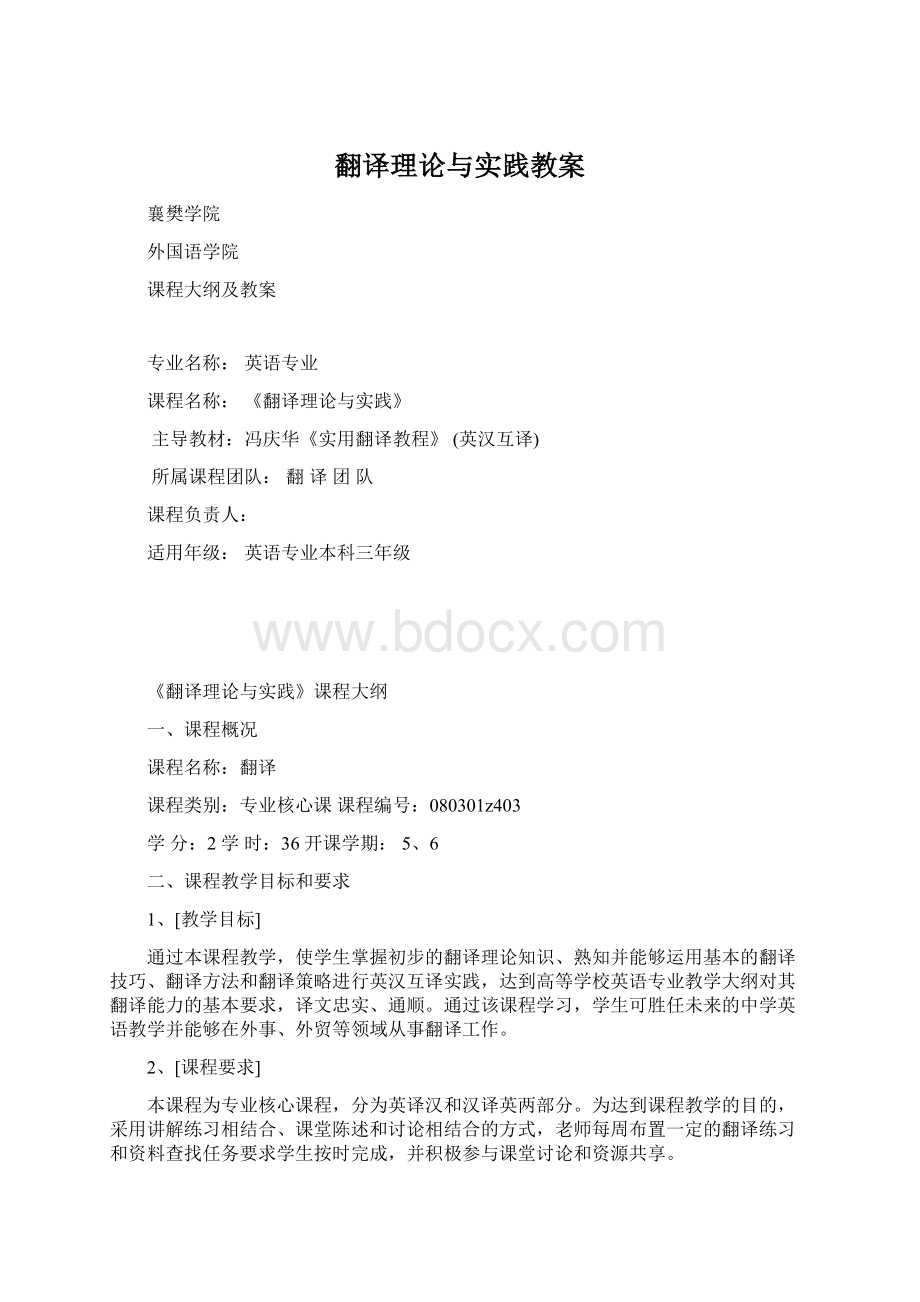翻译理论与实践教案.docx
《翻译理论与实践教案.docx》由会员分享,可在线阅读,更多相关《翻译理论与实践教案.docx(75页珍藏版)》请在冰豆网上搜索。

翻译理论与实践教案
襄樊学院
外国语学院
课程大纲及教案
专业名称:
英语专业
课程名称:
《翻译理论与实践》
主导教材:
冯庆华《实用翻译教程》(英汉互译)
所属课程团队:
翻译团队
课程负责人:
适用年级:
英语专业本科三年级
《翻译理论与实践》课程大纲
一、课程概况
课程名称:
翻译
课程类别:
专业核心课课程编号:
080301z403
学分:
2学时:
36开课学期:
5、6
二、课程教学目标和要求
1、[教学目标]
通过本课程教学,使学生掌握初步的翻译理论知识、熟知并能够运用基本的翻译技巧、翻译方法和翻译策略进行英汉互译实践,达到高等学校英语专业教学大纲对其翻译能力的基本要求,译文忠实、通顺。
通过该课程学习,学生可胜任未来的中学英语教学并能够在外事、外贸等领域从事翻译工作。
2、[课程要求]
本课程为专业核心课程,分为英译汉和汉译英两部分。
为达到课程教学的目的,采用讲解练习相结合、课堂陈述和讨论相结合的方式,老师每周布置一定的翻译练习和资料查找任务要求学生按时完成,并积极参与课堂讨论和资源共享。
三、教学内容与教学安排
1、[教学内容要点]
本课程教学将翻译理论与实践相结合,以实践练习为主,理论讲解为辅,重点是翻译技巧、翻译策略和方法的介绍与翻译练习的讨论和讲解,翻译内容涉及应用文体、小说、诗歌等各类文体、各个领域的文本类型。
课程安排按照讲练结合的原则展开,帮助学生有步骤有针对性地训练翻译的基本技能。
通过大量的练习和讲评,强化学生对不同文本语体特点和翻译原则的认识,为其将来从事翻译工作或运用英语进行跨文化交际打下坚实的基础。
2、[教学安排]
本课程教学依据教学大纲,安排在本科三年级上、下两学期进行,共计68学时,其中36学时为英译汉,32学时为汉译英,每周2学时。
教学计划允许授课教师在具体操作中有一定的灵活度,但至少应包含以下3部分的主题内容:
1)翻译概述(含翻译的标准、原则、过程、中外翻译简史及翻译名家的主要观点等);
2)翻译技巧讲练(介绍主要的英汉互译技巧,结合学生的练笔进行讲评);
3)多视角的翻译实践与研究(不同领域的翻译实践及其操作原则与技巧,如外来词翻译、报刊标题及新闻翻译、旅游翻译、科技翻译、广告翻译、文化与翻译等;在实践的基础上开始涉猎翻译的前沿理论,提高学生对翻译的理性认识,目的在于训练其解决问题的探索能力,为其将来从事翻译实践或理论研究开辟一个窗口)。
四、教材及主要参考资料
教材:
冯庆华:
《实用翻译教程》(英汉互译),上海外语教育出版社,2002年版
陈宏薇:
《新实用汉译英教程》,湖北教育出版社,2000年版
主要参考资料:
Newmark,P.ATextbookofTranslation.Shanghai:
SFLEP,2001.
Nida,E.A.Language,Culture,andTranslating.Shanghai:
SFLEP,1993.
Nida,E.A.LanguageandCulture:
ContextsinTranslating.Shanghai:
SFLEP,2001.
张培基:
《英汉翻译教程》,上海外语教育出版社1980年版
五、作业与考核方式
作业:
各种文本类型的翻译练习;主要翻译理论和重要翻译概念的资料查找和课堂陈述。
考核方式:
课程考核以平时作业和期末开卷考试相结合的方式,考核成绩由平时作业成绩(40%)和期末考试卷面成绩(60%)组成。
TeachingPlanforTranslation
(1)
#TitleofLesson:
ABriefIntroductiontoTranslation
Week1
#TimeNeeded:
Twoperiods(40minutesperperiod)
#TeachingObjectives:
1.Helpthestudentsachieveabasicunderstandingoftranslation:
itsnature,classification,evaluationcriteria,theroleoftranslator,etc.
2.BrieflyintroducetothestudentsthedevelopmentoftranslationinChina.
#KeyTeachingPoints:
1.Thenatureandevaluationcriteriaoftranslation.
2.Thedifficultiesinvolvedintranslatingprocess.
#TeachingContents:
I.Discussion:
●Whatistranslation?
●Whatisasuccessfultranslation?
●Whatdifficultiesmightoccurintranslatingprocess?
A.Whatistranslation?
1.Keywords:
sourcelanguage(SL)/receptorlanguage/targetlanguage(TL);reproduce;message/information;equivalence/correspondence
2.Natureoftranslation(EugeneA.Nida):
Translationconsistsinreproducinginthereceptorlanguagetheclosestnaturalequivalentofthesourcelanguagemessage,firstintermsofmeaningandsecondlyintermsofstyle.
3.Classificationoftranslation:
a.Oralinterpretation/writtentranslation
b.Humantranslation/machinetranslation
c.Literary/scientific/political/commercialtranslation
d.Domestication(naturalization)/foreignization(estrangement,alienation)
e.Literaltranslation/freetranslation
B.Whatisasuccessfultranslation?
1.严复:
信、达、雅(faithfulness,expressiveness,elegance)
2.傅雷:
以效果而论,翻译应当象临画一样,所求的不在形似而在神似
3.钱钟书:
诱、讹、化
4.EugeneA.Nida:
natural/close;dynamic/functionalequivalence
C.Whatdifficultiesmightoccurintranslatingprocess?
1.Language/CulturalBarriers
Translatabilityislowerwhen
(1)theworktobetranslatedisquitedistantbothintimeandspace;
(2)itsformisverymuchunique;(3)thecontentisnotsharedinthetwocultures.
→Betrayal:
Loss/Distortion
2.Exampleanalysis:
a.东边日出西边雨,道是无晴却有晴。
b.纵一苇之所如,凌万顷之茫然
c.Thewholeskyspangledgaytwinklingstars,andtheMilkyWayisasdistinctasthoughithadbeenwashedandrubbedwithsnowforholiday.
——整个天空点缀着繁星,快活地眨着眼。
天河那么清楚地显现出来,就好像有人在过节以前用雪把它擦洗过似的。
d.Hemadeyouahighwaytomybed;
ButI,amaid,diemaiden-widowed.
—RomeoandJuliet
译文1:
他要借你做牵引相思的桥梁
可是我却要做一个独守空闺的怨女而死去。
译文2:
他本要借你做捷径,登上我的床;
可怜我这处女,活守寡,到死是处女。
3.Inthelongrunthereisatendency:
translationitselfcanconvertintranslatabilityintotranslatability.
e.g.crocodile’stears;science/democracy
II.TheRoleofTranslator:
Thecraftoftranslatoris…deeplyambivalent;itisexercisedinaradicaltensionbetweenimpulsestofacsimileandimpulsestoappropriaterecreation.
—GeorgeSteiner
译者的技艺是一个深刻的矛盾体。
这种技艺是在两种冲动的极度张力之间形成的:
一方面是依样画葫芦的冲动,另一方面又有适当再创作的冲动。
A.Metaphorsfortranslator:
1.Acourierofthehumanspirits(普希金)
2.Asculptorwhotriestorecreateaworkofpainting
3.Astraitjacketeddancer
4.Amusician/anactor
5.Traduttori-traditori(Translatorsaretraitors.)
B.Responsibilityoftranslator:
1.Competentlinguisticability&biculturalknowledge
2.Beingastransparentaspossible
3.Beingagoodnegotiator
III.TheDevelopmentofTranslationinChina:
翻译史上的三个高峰期:
1.汉至唐宋佛经的转译:
支谦;鸠摩罗什;道安;玄奘
2.明清以后西欧科技文化的引进:
徐光启;严复;林纾;(译才并世数严林-康有为)
3.五四之后的现代阶段:
郭沫若;鲁迅;瞿秋白;傅雷;钱钟书
IV.Homework:
Peoplewillbeamazedbyherstunningbeautyatthefirstsight.Simpleassheis,natureendowsherwithaninherentattractiveness,whichispolishedandbroughtoutbysophisticatedmoderntechnologyandsuperlativecraftsmanship.Inthisway,innovationsustainsthenature'sartofcreationwhileingenuitywhetspeople'sdesire.
Referencetranslation:
她的美,令人一见惊艳。
她原本生来资质俏丽,再加上现代科技的修饰及极品手艺的打造。
如此一来,她既有天生的美感,又有人工的魅惑。
#TitleofLesson:
ContrastbetweenEnglishandChinese
(1)Week2
#TimeNeeded:
Twoperiods(40minutesperperiod)
#Teachingobjectives:
1.IntroducetothestudentssomebasicdifferencesbetweenEnglishandChinese.
2.Brieflyanalyzetheinfluenceofthesedifferencesontranslating.
#KeyTeachingPoints:
Thedifferenceoflanguageembodiesthedifferenceinthinkingstyles.
#DifficultTeachingPoints:
Theembodimentofdifferentsyntacticfeaturesintranslatingprocess
#TeachingContents:
I.ThinkingStyleandDiction
A.Insubstantial(虚)vs.Substantial(实)
1.Embodiment
e.g.Inthisnewyear,wefacemomentousuncertainties:
war(orwars),aweakeconomy.
译:
这新的一年里,我们面临着战争(乃至连续的战争)、经济低迷等一系列重大的不确定因素。
2.Visualization
e.g.utterlyquiet鸦雀无声
e.g.In1966theNorthKoreanteammadeittothequarterfinals.
译:
1966年,北朝鲜队成功地踢进了四分之一决赛。
B.Static(静)vs.Dynamic(动)
Examples:
1)Comparethefollowingtwosentencesanddecidewhichoneisbetter:
a)Thepopstarappearedonthestage,whichcausedtheaudiencetostandupandapplaud.
b)Thepopstar’spresenceonthestagebroughttheaudiencetotheirfeetinapplause.
2)Translatethefollowingsentence:
Theyaretheemployersofmanagersasmuchastheyaretheemployersofworkpeople.
译:
他们不仅雇佣工人也雇佣经理。
II.ThinkingStyleandSyntax
A.Hypotaxis(从属结构)vs.Parataxis(并列结构)
e.g.Itisapity,however,thatDr.Thomasseemsnottohavelearnedthereallessonthathistoryoffersus–namely,thatthe“greatbreakthroughs”inanytechnologyarealwaysprecededbyaradicalchangeinhowweviewourselves,andhowwebehave.(流水句)
译:
在任何技术取得“重大突破”之前,我们的行为和对自己的看法都会发生剧变——这便是历史给我们的教训。
遗憾的是,托马斯大夫似乎并未真正理解这一点。
(竹节句)
B.Impersonalvs.Personal
1.Inanimatenoun(无灵名词)assubject
e.g.Doubtsbegantocreepintopeople’smindsaboutthelikelysuccessoftheproject.
译:
人们渐渐对这项计划成功的可能性产生了怀疑。
2.Preparatoryword:
it
e.g.Ithurts!
(“it”:
unspecifiedword虚义词)——好疼!
e.g.ItjuststruckmethatIstilloweyoufortheconcerttickets.
译:
我忽然想起还欠你音乐会的门票钱。
3.Passivevoice(hiddenagent/doer)
e.g.ItisgenerallybelievedthatHongKongwillcontinuetokeepitsprosperityandstabilityafteritsreturntoChina.
译:
人们普遍认为香港回归后会继续保持繁荣和稳定。
C.Subject-Prominent(主语句)vs.Topic-Prominent(主题句)
Examples:
1)Wecouldonlybuildonehousewiththesematerials.
译:
这些材料只够我们盖一栋房子。
2)IregarditasanhonorthatIaminvitedtoyourwedding.
译:
被邀请参加您的婚礼,我感到很荣幸。
3)Brightcolorsandboldstrokescharacterizehisearlypainting.
译:
他早期绘画的特征是色彩明亮、笔触大胆。
III.Homework
1.Nowthatyouareinforit,youmustcarryon.
2.Cigaretteswerethedeathofme.
3.IfthemanwhowasseentotakeanumbrellafromtheCityChurchlastSundayeveningdoesnotwishtogetintotrouble,hewillreturntheumbrellatoNo.10BroadStreet.
4.Ifyouconferabenefit,neverrememberit;ifyoureceiveone,rememberitalways.
5.Hersighsmadeitclearthatshewasunhappy.
6.Theyhadnorunningwaterwheretheylived.Nordidtheyhaveanyconveniencesoflifesuchasgasandelectricity.
7.Theatrewillbereinventedandbecomemuchfreerandmoreimaginative.
8.Nowadaysitisunderstoodthatadietwhichcontainsnothingharmfulmayresultinseriousdiseaseifcertainimportantelementsaremissing.
9.Bytheendofthewar,800peoplehadbeensavedbytheorganization,butatacostof200BelgianandFrenchlives.
10.Itshouldbenotedthatheandshewereextremelycloseallies.
Referenceversions:
1.你既然沾上了手,就得干下去。
(形象化)
2.香烟断送了我的性命。
(静-动)
3.上星期日傍晚,有人曾见某君在市教堂取走雨伞一把。
取伞者如不愿卷入纠纷,还是将伞送至布劳德街10号为妙。
(流水句-竹节句)
4.施恩勿记,受恩勿忘。
(省略连接词)
5.她唉声叹气,这说明她不快乐。
(物称-人称)
6.他们住的地方没有自来水,也没有煤气和电这类生活上的便利设施。
(主语-主题)
7.戏剧将脱胎换骨,变得更自由、更富想象力。
(被动-主动:
受事者+动词)
8.如今人们知道,如果食物中缺少了某些重要的成分,即使其中不含有任何有害的物质,也会引起严重的疾病。
(被动句-泛称句)
9.大战结束时,这个组织拯救了800人,但那是以200多比利时人和法国人的生命为代价的。
(施事者直接作主语)
10.应当指出,他和她是极为密切的盟友。
(被动句-无主句)
#TitleofLesson:
ContrastbetweenEnglishandChinese
(2)Week3
#TimeNeeded:
Twoperiods(40minutesperperiod)
#TeachingObjectives:
1.IntroducetothestudentssomebasicdifferencesbetweenEnglishandChinese.
2.Brieflyanalyzetheinfluenceofthesedifferencesontranslating.
#KeyTeachingPoints:
1.Lexicaldifferences;
2.Syntacticdifferences.
#DifficultTeachingPoints:
Theembodimentofdifferentsyntacticfeaturesintranslatingprocess
#TeachingContents:
I.Commentonthehomework
II.LexicalDifferences
A.Wordmeaning
1.Exactequivalent
e.g.thePacificOcean;palace(**comparewithdragon)
2.Noequivalent
e.g.mascon,cosplay→atendencyoftranslatability(e.g.bar,disco)
3.Partialequivalent
a.Polysemy(一词多义)
e.g.aunt,bird,drink,homely
e.g.tocutwheat/cake/finger-nails
e.g.tohavedinner
tohaveabeard
toha